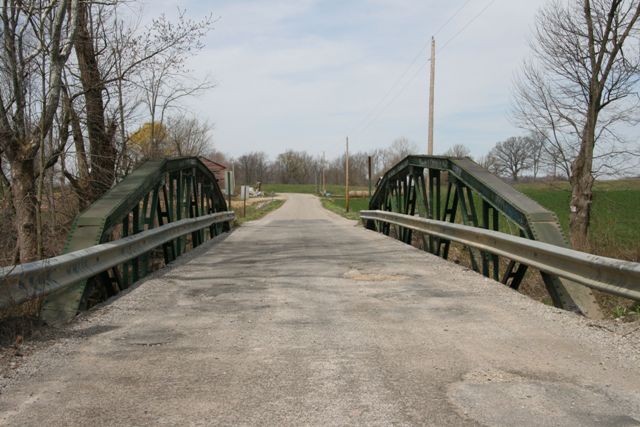We Recommend:
Bach Steel - Experts at historic truss bridge restoration.
BridgeHunter.com Phase 1 is released to the public! - Visit Now
Omega Road Bridge

Primary Photographer(s): Rick McOmber
Bridge Documented: April 18, 2009
Rural: Huron County, Ohio: United States
Not Available or Not Applicable
81.0 Feet (24.7 Meters)
84.0 Feet (25.6 Meters)
15.4 Feet (4.69 Meters)
1 Main Span(s)
3948315

View Information About HSR Ratings
Bridge Documentation
This bridge no longer exists!
Bridge Status: Demolished and replaced.View Archived National Bridge Inventory Report - Has Additional Details and Evaluation
The bridge is a traditional example of a riveted polygonal warren pony truss. Field bolts on the otherwise riveted connections show the points where the prefabricated trusses were assembled in the field. The bridge retains good historic integrity although original railings were replaced with Armco guardrail. While the guardrail is an aesthetic detriment, the curved shape of the polygonal top chord continues to make this bridge an attractive structure.
At the time of documentation, the bridge displayed dirt buildup on the bottom chord. Owners of bridges need to wash bridges occasionally as part of a proper routine maintenance program to ensure that dirt does not build up in this manner, trapping moisture and leading to avoidable structure deterioration.
This bridge was stated as a later example of a standardized design in Ohio. While a number of earlier rivet-connected Warren pony truss bridges may exist (or did exist) in Ohio, this is an extremely early example of a polygonal Warren truss. Most polygonal Warren pony truss bridges date to 1920 and later. The Historic Bridge Inventory overlooked this fact.
Information and Findings From Ohio's Historic Bridge InventorySetting/Context The bridge carries a 1 lane road over a stream in a rural area of active farms. Physical Description The 1 span, 84'-long, rivet-connected Warren pony truss bridge has polygonal upper chord ,verticals, and built-up members. The upper chord is composed of toe-out channels with cover plate and lacing. The verticals, diagonals, and lower chords are angles with battens. The built-up floorbeams are connected above the lower-chord panel points. The bridge is supported on concrete abutments. Integrity The bridge has some bolted repairs at the polygonal upper chord gusset plates Summary of Significance Although complete except for some bolted repairs, the Warren with verticals pony truss bridge placed in 1910 by the county is not historically or technologically significant. It is a later example of a
standardized design that was used throughout the state. The fabricator is not documented. Extant riveted pony truss bridges in Ohio date to 1897 (25XXXX1), and it is the early examples that represent the transfer of technology from
pinned to riveted field connections. Bridge Considered Historic By Survey: No |
![]()
Photo Galleries and Videos: Omega Road Bridge
Bridge Photo-Documentation
Original / Full Size PhotosA collection of overview and detail photos. This gallery offers photos in the highest available resolution and file size in a touch-friendly popup viewer.
Alternatively, Browse Without Using Viewer
![]()
Bridge Photo-Documentation
Mobile Optimized PhotosA collection of overview and detail photos. This gallery features data-friendly, fast-loading photos in a touch-friendly popup viewer.
Alternatively, Browse Without Using Viewer
![]()
Maps and Links: Omega Road Bridge
This historic bridge has been demolished. This map is shown for reference purposes only.
Coordinates (Latitude, Longitude):
Search For Additional Bridge Listings:
Bridgehunter.com: View listed bridges within 0.5 miles (0.8 kilometers) of this bridge.
Bridgehunter.com: View listed bridges within 10 miles (16 kilometers) of this bridge.
Additional Maps:
Google Streetview (If Available)
GeoHack (Additional Links and Coordinates)
Apple Maps (Via DuckDuckGo Search)
Apple Maps (Apple devices only)
Android: Open Location In Your Map or GPS App
Flickr Gallery (Find Nearby Photos)
Wikimedia Commons (Find Nearby Photos)
Directions Via Sygic For Android
Directions Via Sygic For iOS and Android Dolphin Browser
USGS National Map (United States Only)
Historical USGS Topo Maps (United States Only)
Historic Aerials (United States Only)
CalTopo Maps (United States Only)

